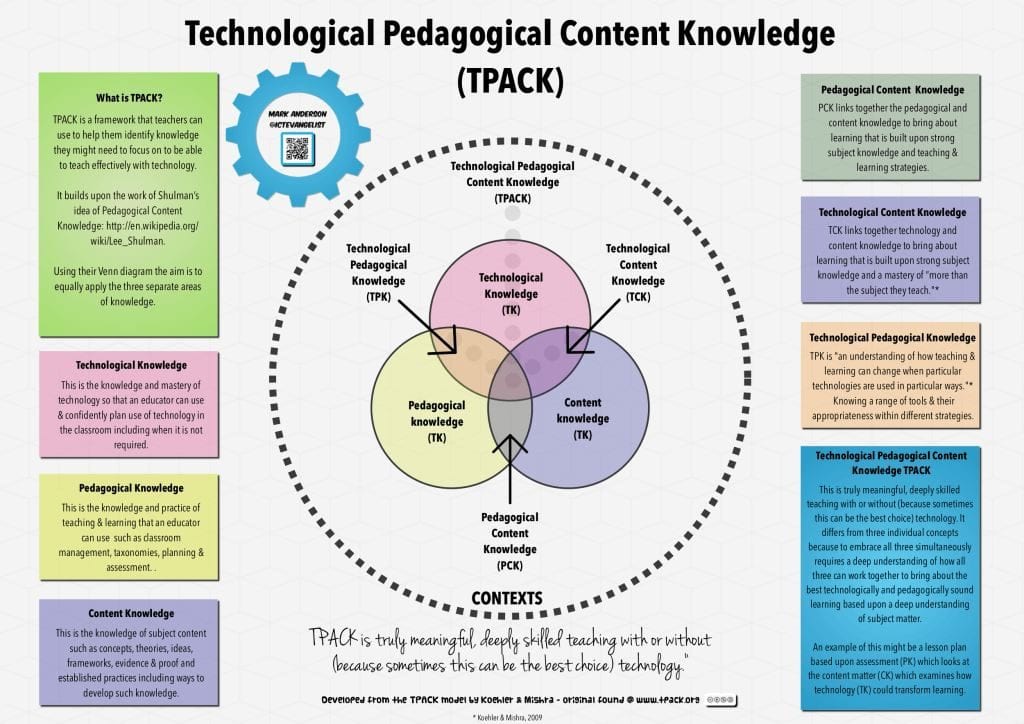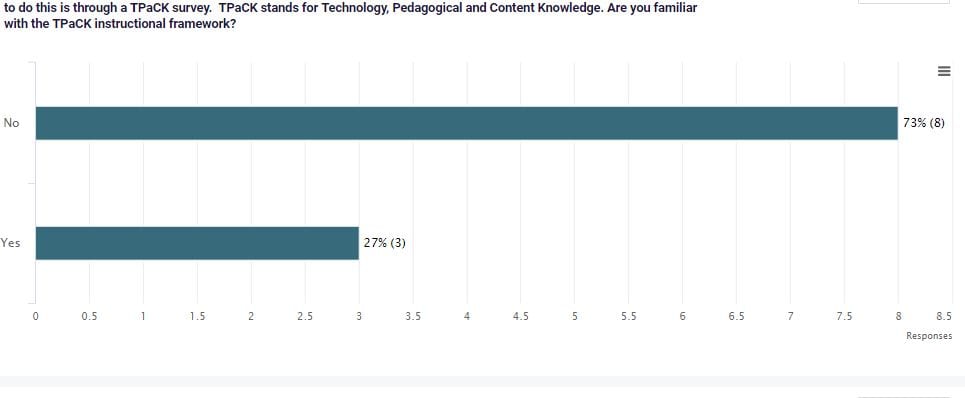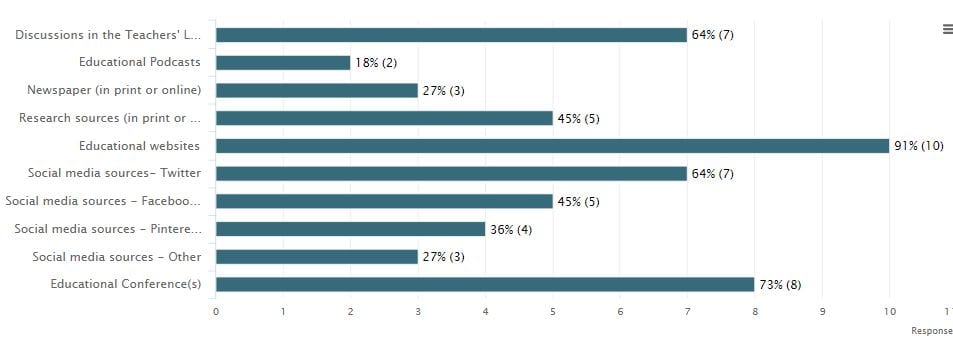TPaCK for Newbies
What is TPaCK? Technological Pedagogical Content Knowledge
TPaCK is the collective acronym for the combination of technological, pedagogical, and content knowledge that teachers blend to provide student-centered instruction (Koehler & Mishra, 2005a; Koehler & Mishra, 2005b; Koh et al., 2014; Mishra & Koehler, 2006). Researchers and Professors Mishra and Koehler (2006) extended extend Shulman’s (1987) seminal work connecting pedagogy and content knowledge.
Shulman’s research (1987) integrated both content knowledge and pedagogical knowledge to more fully represent and support the complexity of effective teaching.Shulman’s research established that high-quality teachers use two domains, content knowledge, and pedagogical knowledge to promote meaningful learning. Content Knowledge (CK) is curricular subject matter knowledge and Pedagogical Content Knowledge (PCK) is how to teach content.
Previously these concepts were considered separate, but Shulman emphasized the blending of content knowledge (CK) and pedagogical knowledge (PK). Knowledge of the pedagogy inherent in the teaching process is represented as PK (Shulman, 1987). Perhaps the most straightforward of the framework’s components is content knowledge (CK). It is what teachers know about what they teach.
Shulman combined the two constructs of PK and CK in the acronym of PCK. Shulman described PCK as the “understanding of how particular topics, problems, or issues are organized, represented, and adapted to the diverse interests and abilities of learners, and presented for instruction” (1987, p. 8).
When combined, pedagogy and content knowledge (PCK) is reflected in teachers’ curriculum content and instructional decisions. As teachers group content, standards, and key facts together, they consider the best sequencing for curriculum pacing. They also think about how and when to present curriculum in ways that meet students’ learning needs (Shulman, 1987). Finally, they consider best practices for re-teaching content that is not mastered by students.
Examples of pedagogical content knowledge (PCK) include project-based learning, the pacing of instruction, curriculum compacting, assessment strategies, and the process of differentiating content for the abilities and interests of all learners.
As an example, in College Prep Math, one component of a teacher’s Content Knowledge (CK) would be knowing how to multiply matrices. The PK would include knowing how to explain this knowledge to a student by using conversational language and applying the correct mathematical symbols and phrases in y-step progression. Teachers’ pedagogical techniques include an understanding of what makes mathematical concepts easy or difficult to learn for students. Shulman asserted that effective instructors have a unique and specialized pedagogy and content knowledge (PCK) that sets them apart and is unique and highly qualified (Mishra & Koehler, 2009).
Using Shulman’s work as a foundation, a framework was developed to address the addition of teachers’ technological skill (Koehler & Mishra, 2005a; Koehler & Mishra, 2005b; Mishra & Koehler, 2006) and fused the additional component of technology to Shulman’s pedagogy and content knowledge (PCK). The TPaCK instructional framework extended Shulman’s theory of pedagogical content knowledge (PCK) with a specific affordance for effective teaching with technological knowledge (TK) and technological content knowledge (TCK) and technological pedagogical knowledge (TPK) (Koehler & Mishra, 2005a; Koehler & Mishra, 2005b; Mishra & Koehler, 2006).
The resulting TPaCK instructional framework connects technological, pedagogical, and content knowledge in seven intersecting categories of instructional practices (Koehler & Mishra, 2005a; Koehler & Mishra, 2005b; Koh et al., 2014; Koh, Chai, Wong, & Hong, 2015; Mishra & Koehler, 2006). The seven categories of TPaCK are: Technological Knowledge (TK), Content Knowledge (CK), Pedagogical Knowledge (PK), Pedagogical Content Knowledge (PCK), Technological Content Knowledge (TCK), Technological Pedagogical Knowledge (TPK), and Technological Pedagogical Content Knowledge (TPaCK).
The TPaCK model highlights interactions between and among the PCK, TCK (technological content knowledge), and TPK (technological pedagogical knowledge) components. Context is the connecting component. TPaCK provides a context for the dynamic and fluid nature caused by frequent updates of technology and content presentation. The attribute categories of Technology, Pedagogy, and Content Knowledge are not “mutually exclusive” (Mishra & Koehler, 2006, p. 1042).
Context is the connector. TPaCK is “grounded in the context of practice” (Mishra & Koehler, 2006, p. 100). In the most effective instructional environments, both online and face-to-face courses, the TPaCK attributes are interconnected (Mishra & Koehler, 2006). The intersecting boundaries of these three domains forms the interplay of TPaCK (Figure 1).

Figure 1: The components of the TPaCK framework. Reproduced by permission of publisher, http:// tpack.org
Online instructor/facilitators with emerging Technological Knowledge (TK) know how to navigate through a catalog of tools or an online inventory of hardware. Yet, that is not the complete picture. Technological Knowledge (TK) is knowing which tools to configure in the best infrastructure. Technological Knowledge (TK) is understanding cross-platform applications and capabilities. Online instructor/facilitators with growing TK skills also know when and how to work with the information technology (IT) specialist and how to describe inevitable technology issues. They use a “systematic approach” (Hilton, 2016, p. 68) to increase and maintain the technical competence needed to stay up-to-date for students. One of the best advantages of TK is its capacity to know which tools to use to create a personal connection with more learners than with traditional face-to-face classrooms communication. This is especially significant in online courses. Online course instructor/facilitators achieve personal connection with learners through voice-to-text apps, short video for check-in, individualized emails, and personalized discussion board posts. In the technological, content knowledge (TCK) domain is the knowledge about how course content needs to be delivered using technology (Koehler & Mishra, 2009; Mishra & Koehler, 2006). Technological content knowledge (TCK) represents the mutual relationship between emerging technology and teaching subject-matter content. For example, in teaching geometry, a foundational technology was the overhead projector with rolling transparency film to teach theorems. TCK understanding would now include whiteboards, document cameras, and teacher and student created videos, and video capture tools to teach theorem concepts. TCK is “discipline specific” (Spires, Wiebe, Young, Hollebrands & Lee, 2012), matching the most appropriate and cost-effective technology tools to teach curricular concept mastery. Thinking about TCK and its application with various new media and technology tools might shape conversations about future institutional use.
Technological pedagogical knowledge (TPK) refers to the understanding of how teaching and learning can change when technology is used in particular ways (Koehler & Mishra, 2009). Technological pedagogical knowledge (TPK) refers to the teacher’s ability to know how to use technology for instructional purposes. TPK primarily entails both a familiarity of hardware, software and how they can be used in teaching and learning. TPK also includes teachers’ understanding of how their instruction might change as a result of using a specific technology.
Educators must consider not only how to teach curricular concepts to students but also how to provide instruction in the technology being used. Examples of TPK include when to use an online or social media resource, how to create a formative or summative online quiz, and how to effectively reply to a learner’s email, or when cross-platform facility is needed between the Windows and Mac operating systems and among different web navigational browsers. Yet this knowledge alone is insufficient without deep subject matter knowledge.
TPaCK reflects the pedagogical changes in content delivery from just-in-case learning to just-in-time learning (Duderstadt, 1997; Koh & Divaharan, 2011). The U.S. Department of Education uses the TPaCK skill set as an assessment option in its Race to the Top grants program (Department of Education, 2010). The collective cluster of skills in instructor’s lesson plans may be identified and assessed in concrete rubrics (Koehler et al., 2017). However, TPaCK is not confined as a rubric assessment tool. It is “an understanding that emerges from interactions among content, pedagogy, and technology knowledge… underlying truly meaningful and deeply skilled teaching with technology” (Koehler, Mishra & Cain, 2013, p. 66). A slightly modified rendering of the TPaCK acronym with a lowercase letter “a” reflected more precisely the connecting and inclusive focus of the word “and” is often expressed in research published after 2014.
Examples of content knowledge needed for online courses reflect dates, facts, vocabulary, and concepts combined with technology tools and mobile apps. Merely uploading scanned copies of content notes or an instructor’s published research robs the learner of the social media conveyance of the current Web 2.0. It negates the pedagogy knowledge of online course content delivery and without considering this aspect, learning online will be stunted.
Knowing how to deliver content using optimal methods for knowledge transfer to course participants is the pedagogical goal of TPaCK. Using TPaCK skills in an online course reflects content knowledge but also knowing where this information resides online, how it is sequenced and how much is delivered at one time. Successful technological content knowledge involves “sequencing and chunking of materials” (Song & Yuan, 2015, p. 732) in ways that invite discussion and limit cognitive overload.
TPaCK corrals the special kinds of instructional organization demonstrated by instructors as they adroitly integrate technology into pedagogy and content curriculum (Koehler & Mishra, 2005; Koehler & Mishra, 2005b; Mishra & Koehler, 2009). Technological Knowledge (TK) is an extensive understanding of technology tools and resources. With technological knowledge, all the hardware gadgets are repurposed as beneficial classroom learning catalysts. Each technology tool has “affordances and constraints, potentials and problems” (Mishra & Koehler, 2009, p. 15).
In an example of putting all the TPaCK components together, an online teacher must know the pedagogy (technology/pedagogy knowledge) of combining shorten subject matter content bursts and abbreviated hyperlinks (technology/content) for the best rendering on a mobile device screen. S/he must know how to craft a concise and engaging discussion prompt or reply to a learners’ discussion forum post (pedagogy/technology/content/) and when to comment to add depth to an online class discussion board or real-time synchronous discussion (technology/pedagogy/content). TPaCK is a necessary framework to measure online teaching and learning because it captures what teachers currently do to increase student engagement (Koehler & Mishra, 2009; Mishra & Koehler, 2006).
Successful teaching and learning online occurs through the instructor’s combinatory use of the TPaCK instructional framework (Koehler & Mishra, 2009; Mishra & Koehler, 2006). The TPaCK instructional framework applies the theoretical concepts of constructivism and constructionism in online course design mediated with mobile technology. One example combining TPaCK with constructivist and constructionist learning theories would be online discourse between instructor and learners on the design and eventual production of an avatar- infused video. The avatar-video becomes not only a way to connect content components but also a way to think, discussion and create a learning artifact Reflecting about the video presentation, expression, concise language script, and digital storytelling components vaults the video to a “rich artifact” (Koehler et al., 2017, p. 40).
Learning online and with mobile technology is enhanced by course content that is multimodal in its constructionist design and promotes constructivist “in-situ improvisation and …sharing and creation of student artefacts [sic] on the move” (So, 2009, p. 217). The application of TPaCK for online education continues to grow (Archambault, 2016; Archambault & Barnett, 2010). As a conceptual model to measure the interplay between instructional components in learning, TPaCK has been the focus of many empirical research studies.
TPaCK studies occur in K-12, face-to-face settings (Gomez, 2015; Jen, Yeh, Hsu, Wu, & Chen, 2016; Koh et al., 2014), higher education (Archambault, 2016; Archambault, & Barnett, 2010; Archambault & Crippen, 2009), and blended learning environments (Watson & Murin, 2014; Watson, Murin, Vashaw, Gemin, & Rapp, 2013). These studies indicate that TPaCK is a valid strategy to measure the knowledge instructors need to facilitate learning with technological components. However, these studies did not give the fullest picture of how instructors used TPaCK in their lesson plan practices and lesson design practices (Koh et al., 2014). The methods used by instructors would create blueprints of practice for others. …
TPaCK combines and interconnects all the separate components of technology, pedagogy, and content knowledge (Koehler & Mishra, 2009; Mishra & Koehler, 2006). The convergence of the TPaCK domains mirror the relational and interrelated aspects of Bloom’s Revised Cognitive and Affective Taxonomies (Koh, Chai & Tsai, 2010). Context is important within the TPaCK domains. Dissecting each component of the TPaCK reveals its ineffectiveness as a stand-alone instructional delivery means. The domains need their combined synergy. Examples of TPaCK applied to face-to-face and online education require relational interplay between not only content itself, but how context is presented, discussed and applied in an online environment accessed with mobile technology.
~~Excerpt from “A Mixed Methods Study of Online Facilitators’ Perceptions of Mobile Technology, Design, and TPaCK Affordances.” Helen Teague, 2017. pp. 20-29. DOI: 10.13140/RG.2.2.29276.39044
Available online at ProQuest and Research Gate: http://goo.gl/Wdp9CU and https://eric.ed.gov/?id=ED576873
References:
Archambault, L. (2016). Exploring the use of qualitative methods to examine TPACK.
In M. C. Herring, P. Mishra, & M.J. Koehler, (Eds.). Handbook of Technological
Pedagogical Content Knowledge (TPACK) for Educators. New York, NY: Routledge.
Archambault, L., & Crippen, K. (2009a). Examining TPACK among K-12 online distance educators in
the United States. Contemporary Issues in Technology and Teacher Education, 9(1), 71-88.
Archambault, L., & Crippen, K. (2009b). K–12 distance educators at work: Who’s teaching online
across the United States. Journal of Research on Technology in Education, 41(4), 363-391.
Archambault, L. M. and J. H. Barnett (2010). Revisiting technological pedagogical content
knowledge: Exploring the TPACK framework. Computers & Education 55(4), 1656-1662.
Duderstadt, J. J. (1997). The future of the university in an age of knowledge. Journal of Asynchronous
Learning Networks, 1(2), 78-88.
Koehler, M. J., & Mishra, P. (2005b). What happens when teachers design educational technology?
The development of technological pedagogical content knowledge. Journal
of Educational Computing Research, 32(2), 131-152.
Koehler, M., & Mishra, P. (2009). What is technological pedagogical content knowledge
(TPACK)? Contemporary issues in technology and teacher education, 9(1), 60-70.
Koehler, M. J., Mishra, P., & Cain, W. (2013). What is technological pedagogical content knowledge
(TPACK)?. Journal of Education, 193(3).
Koehler, M. J., Mishra, P., & Yahya, K. (2007). Tracing the development of teacher knowledge in a
design seminar: Integrating content, pedagogy and technology. Computers & Education,
Koh, J. H. L., Chai, C. S., Benjamin, W., & Hong, H.-Y. (2015). Technological pedagogical content
knowledge (TPACK) and design thinking: A framework to support ICT lesson design for 21st
century learning. The Asia-Pacific Education Researcher, 24(3), 535-543.
Koh, J. H. L., Chai, C. S., Hong, H. Y., & Tsai, C. C., (2014). A survey to examine teachers’
perceptions of design dispositions, lesson design practices, and their relationships with
technological pedagogical content knowledge (TPACK). Asia-Pacific Journal of Teacher
Education, (pp. 1-14). doi:10.1080/1359866X.2014.941280
Koh, J. H. L., Chai, C. S., & Tsai, C. (2010). Examining the technological pedagogical content
knowledge of Singapore pre‐service teachers with a large‐scale survey. Journal of
Computer Assisted Learning, 26(6), 563-573.
Koh, J. H. L., Chai, C. S., & Tsai, C. (2014). Demographic factors, TPACK constructs, and teachers’
perceptions of constructivist-oriented TPACK. Journal of Educational Technology & Society,
17(1), 185-196. Unique Identifier: 5892498774
Koh, J. H., & Divaharan, H. (2011). Developing pre-service teachers’ technology integration expertise
through the TPACK-developing instructional model. Journal of Educational Computing
Research, 44(1), 35-58.
Mishra, P., & Koehler, M. (2006). Technological pedagogical content knowledge: A framework for
teacher knowledge. The Teachers College Record, 108(6), (pp. 1017-1054).
Mishra, P., & Koehler, M. (2009). Too cool for school? No way! Using the TPACK framework:
You can have your hot tools and teach with them, too. Learning & Leading with Technology,
36
(7),14-18. Unique Identifier: 425589912.
Shulman, L.S. (1987). Knowing and teaching: Foundations of the new reform. Harvard Educational
Review, 57(1), 1-32. doi:10.17763/haer.57.1.j463w79r56455411
Shulman, L. S., & Sherin, M. G. (2004). Fostering communities of teachers as learners:
Disciplinary perspectives. Journal of Curriculum Studies, 36(2), 135-140.
doi:10.1080/0022027032000135049
Song, M. & Yuan, R. (2015, April). Beyond social presence: Increasing cognitive presence through
meaningful interaction. Proceedings of Global Learn 2015, (pp. 731-736). Association for the
Advancement of Computing in Education (AACE). Retrieved from
http://www.editlib.org/p/150924
Watson, J., Murin. A. (2014). A history of K-12 online and blended instruction in the United States.
In R.E. Ferdig & K Kennedy (Eds.). Handbook of research on K-12 online and blended
learning, (pp. 1-23). Pittsburgh, PA: ETC Press.
Watson, J., Murin, A., Vashaw, L, Gemin, R., & Rapp, C. (2013). Keeping pace with K-12 online
and blended learning: A guide to policy and practice. Evergreen Education Group. Retrieved
from: http://www.kpk12.com/wp-content/uploads/EEG_KP2013-lr.pdf









